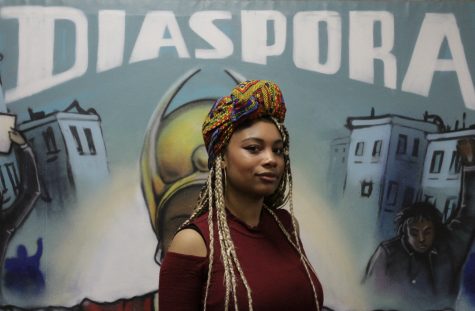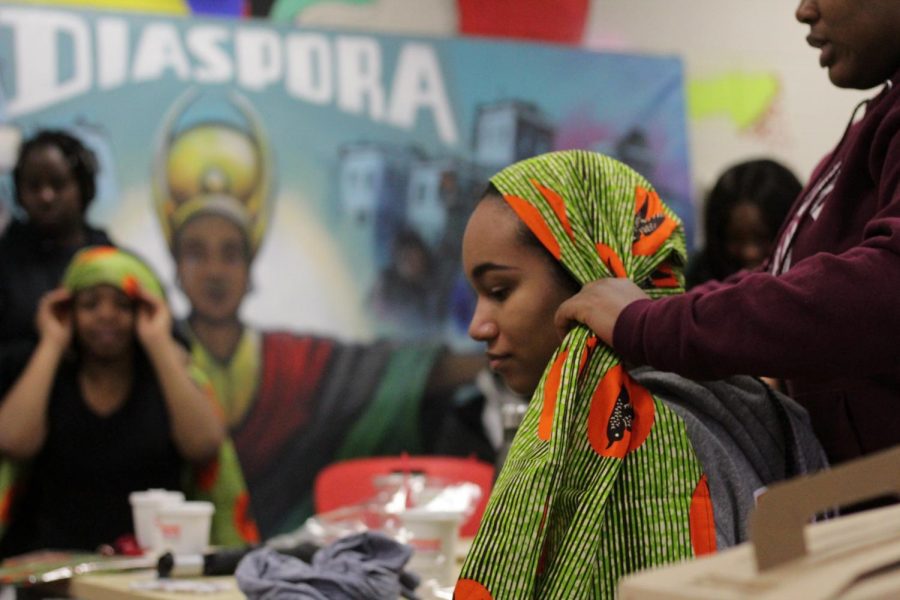UMass freshman Trinity Monteiro, a sport management and marketing double major, sits patiently as her friend tries to wrap her head in a front doughnut wrap. (Brian Choquet/Amherst Wire)
The beauty in fabric: Headwrapping tutorials celebrating Black History Month hosted by UMass SoCA, iMOSÉ, AACE
February 13, 2018
AMHERST — At 10 years old, University of Massachusetts Amherst junior Stephnie Igharosa was a self-proclaimed tomboy when she reluctantly let her mother wrap her head in a traditional Nigerian gele. As her mom wrapped and tied the fabric around her head in preparation for a church event, Igharosa felt what she described as a “beautiful bond and communion” with her mother.

iMOSÉ Wraps, a bimonthly subscription service that specializes in headwraps, put on display different headwrap styles. The event allowed UMass junior Stephnie Igharosa to promote her startup after creating the business at the end of last year. (Brian Choquet/Amherst Wire)
To this day Igharosa still holds on to that belief that head-wrapping can bring people together as she and her start-up business, iMOSÉ Wraps, helped UMass group Students of Caribbean Ancestry organize a lively head-wrapping demonstration. The event was held at the Malcolm X Cultural Center Saturday, Feb. 10 and was also assisted by the Alliance for Afro-American Cultural Education who provided scarves to the first 20 people to arrive.
The event was meant to celebrate black empowerment during Black History Month, and to bring awareness to the history and importance of head-wrapping in black culture.
“We really wanted to kick [Black History Month] off with something that was central to the black community but could also fit in line with our mission, which is to spread the influence of the Caribbean,” said SoCA President and UMass junior Cassandra Georges.

Esthel Jean, a UMass junior and a stylist for iMOSÉ Wraps, jokes around with the crowd as she attempts to demonstrate a bow wrap on attendee Franzchesca Dormeus, a sophomore African-American studies major at UMass.
“It’s just about having a good time,” said Jean. “You’re not gonna look like every single person out there modeling these headwraps.” (Brian Choquet/Amherst Wire)
In a vibrant yellow African print headwrap, UMass junior and iMOSÉ stylist Esthel Jean led the tutorials to a crowd of almost 30 women. As most grasped onto their complementary orange, blue or green scarves, Jean demonstrated five different headwrapping styles including her favorite, the front doughnut wrap.
Laughter and confused faces filled the room as people attempted to follow Jean’s step-by-step instructions. While not everyone ended up perfecting the different wraps, the event achieved Georges’ goal of providing a welcoming space for the black community on campus.
“We’re such a small percentage of the campus,” said Georges. “Sometimes it’s easy to feel lost so it’s nice when we have these events where lots of them come in and just feel like ‘there is a space for me here.’”

Dormeus was Jean’s honorary head dummy as she was used for all five headwrapping demonstrations. She is no stranger to headwrapping, but the event gave Dormeus her first headwrap — an upgrade from the t-shirts she usually uses to wrap her hair. “It was really beautiful, during Black History Month, seeing all these black women here just wrapping headwraps and learning about the history,” said Dormeus. (Brian Choquet/Amherst Wire)
In the fall semester of 2017, only five percent of the UMass Amherst student population identified as black or African-American.
“It’s great for us to bring some cultural awareness to the campus but also connect to our fellow brothers and sisters by bringing them things that they can connect with and things they can use in their everyday life,” said Igharosa.
For members of the black community, headwraps mean more than a pretty piece of fabric. Before the tutorials began, Igharosa led a discussion and played a video on the history of headwrapping. They can be traced back to sub-Saharan Africa, where they symbolized the spirituality and prosperity of the women who wore them.
However, during the time of slavery in the U.S., headwraps became a symbol of shame for female slaves. Even after slavery was abolished in 1865, headwraps did not become a prominent part of black culture.
It wasn’t until the civil rights movement when headwraps started to enter mainstream black culture. They began to represent black pride and the reclaiming of a one’s black heritage. They also acted as a fashionable hair accessory and a stylish way for people to keep their hair healthy in harsh sunlight.
“What’s so great about headwrapping is that it has so many different utilities,” said Igharosa. “I think as we use headwraps we’re kind of reclaiming our identity and using it to celebrate who we are.”

For Jean, headwrapping has become a way for her to reclaim parts of her culture that she believes have been used as a suppressive tool. “It’s a great way to style something and to reclaim something of my culture and of my history,” said Jean. (Brian Choquet/Amherst Wire)
Reclaiming of one’s cultural identity speaks closely to Jean’s journey into headwrapping. She wasn’t always passionate about the practice or even fully confident embracing herself and her culture.
“I was just comfortable in fitting in with whatever the standard may have been, even if they were unachievable for me,” said Jean. “I think I always aspired to not really stand out in that sense.”
It wasn’t until she became enamored by her cousin’s confidence and eccentric, colorful style, including a skillfully wrapped headwrap, that she started embracing her own culture and her individuality.
Now, on most days, you’ll be able to find Jean walking around campus proudly wearing not just her vibrant front doughnut wrapped headwrap, but her confidence as well.
Email Brian at [email protected] or follow him on Twitter @brianshowket.

